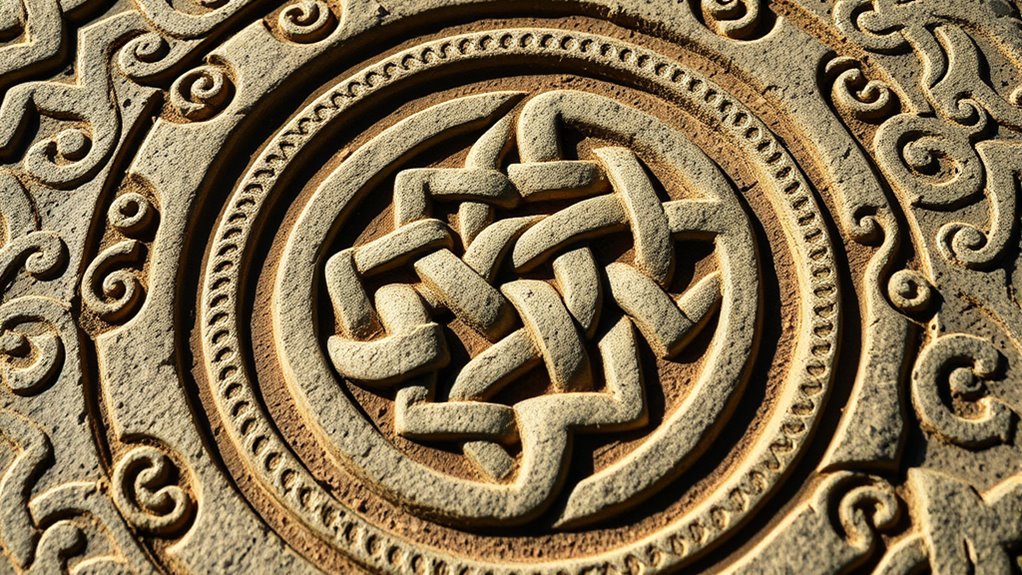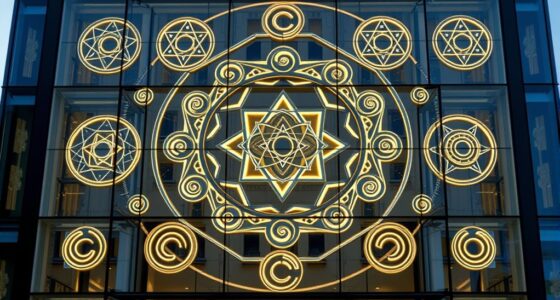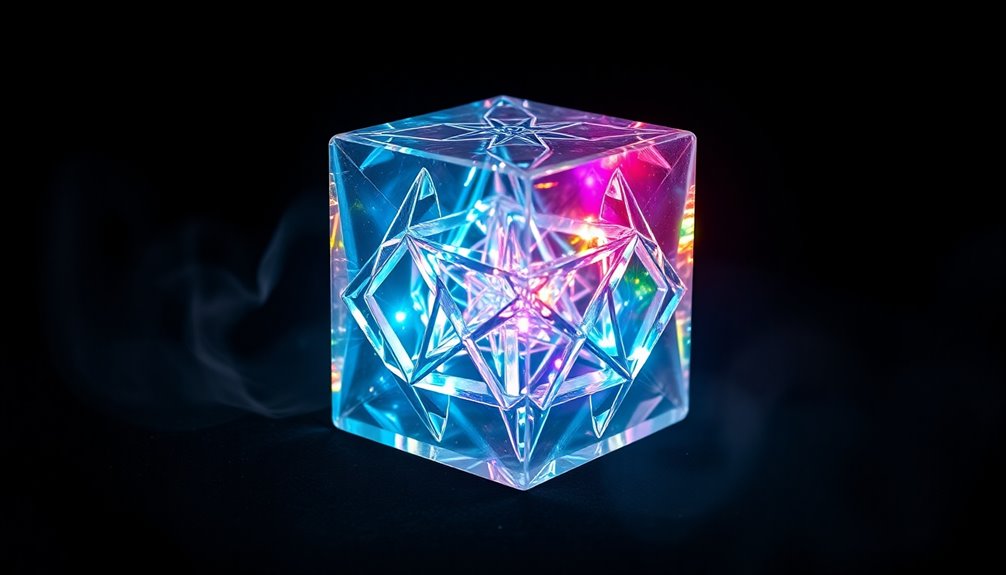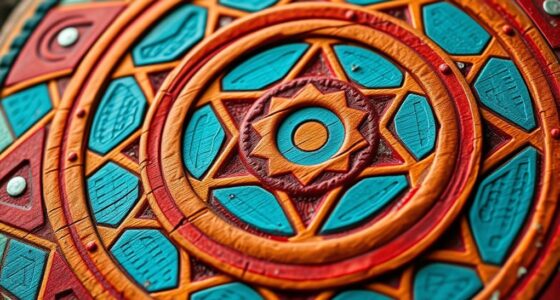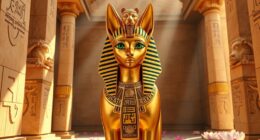Celtic knots and labyrinths are ancient symbols that represent eternity, interconnectedness, and spiritual journeys. You’ll see them woven into jewelry, carvings, and sacred sites, symbolizing unity, life cycles, and self-discovery. These intricate patterns have roots in prehistoric and early Christian times, serving as protectors, spiritual guides, and meditative tools. To uncover their deeper meanings and cultural significance, continuing your exploration will reveal more about these sacred designs.
Key Takeaways
- Celtic knots symbolize eternity, interconnectedness, and unity, reflecting spiritual beliefs and cultural identity.
- Labyrinths represent spiritual journeys, self-discovery, and divine connection, guiding personal transformation.
- Both patterns originate from early medieval and prehistoric times, serving as protective symbols and spiritual tools.
- Celtic knots incorporate motifs from nature and mythology, embodying harmony and continuous life cycles.
- These sacred patterns continue to inspire modern spiritual practices and cultural expressions worldwide.
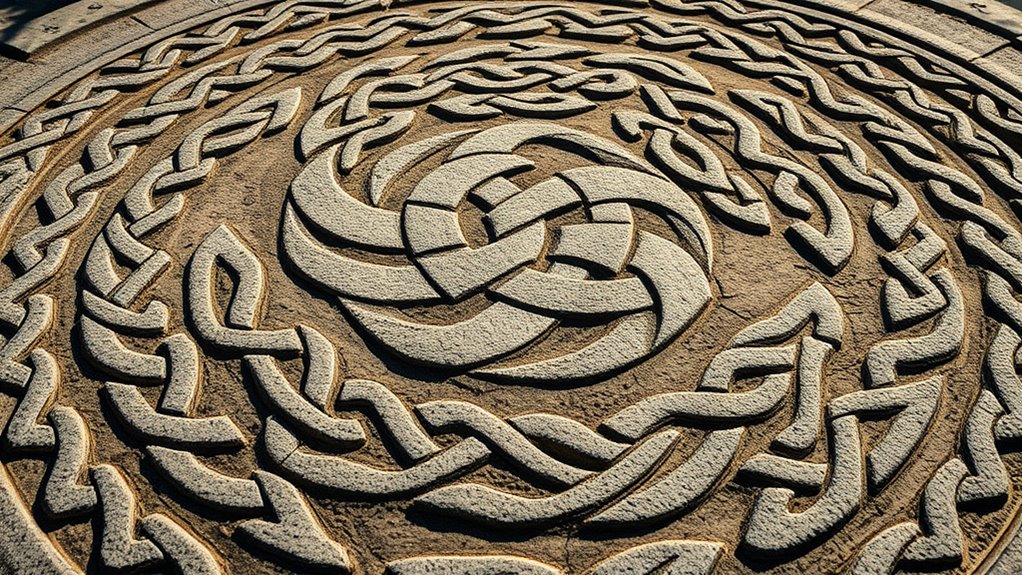
Have you ever wondered why Celtic knots and labyrinths continue to fascinate us across centuries? These intricate patterns are more than just decorative art; they hold deep symbolism and carry stories that span thousands of years. Understanding their symbolism meanings reveals how these designs connect us to the spiritual beliefs and cultural identity of the Celtic people. Celtic knots, characterized by endless loops with no beginning or end, symbolize eternity, interconnectedness, and the cycle of life and death. They represent the continuous flow of life and the unity of spirit and matter, embodying concepts of eternity and harmony. Meanwhile, labyrinths often serve as spiritual journeys, symbolizing a path to self-discovery, enlightenment, or divine connection. Their complex, winding paths mirror life’s twists and turns, urging you to reflect on your personal journey and growth. The patterns themselves often incorporate symbolism derived from nature, mythology, and spiritual traditions, adding layers of meaning to their intricate designs.
Tracing the historical origins of these designs offers insight into their enduring significance. Celtic knots date back to the early medieval period, with some of the earliest examples appearing in Christian manuscript illuminations like the Book of Kells. Originally, these patterns were believed to have protective qualities, warding off evil spirits and bringing good fortune. Over time, the motifs evolved, integrating Christian symbolism while retaining their pagan roots. These patterns were carved into stones, woven into jewelry, and painted on sacred objects, serving both decorative and spiritual functions. The labyrinths, on the other hand, are even older, with roots in prehistoric Europe. They appeared in Neolithic and Bronze Age sites as ritual symbols, often associated with pilgrimage, healing, and initiation rites. These designs were believed to facilitate spiritual transformation, guiding the seeker through a symbolic journey toward enlightenment or divine union.
Frequently Asked Questions
What Materials Were Traditionally Used to Create Celtic Knots?
You’ll find that Celtic knots were traditionally crafted using materials like ancient parchment, which allowed for detailed drawings and designs. Skilled artisans also used metalwork adornments, such as bronze or silver, to create intricate jewelry and decorative pieces featuring these patterns. Sometimes, stone or wood was carved with Celtic knot motifs for monuments and artifacts. These materials helped preserve and showcase the sacred, timeless nature of Celtic knot artistry.
How Do Celtic Labyrinths Influence Modern Spiritual Practices?
You find that Celtic labyrinths serve as powerful symbols in your modern spiritual practices, guiding meditative journeys inward. Their intricate pathways symbolize life’s interconnectedness, encouraging reflection and mindfulness. By tracing their patterns, you deepen your spiritual symbolism understanding, fostering inner peace and clarity. These labyrinths inspire you to explore your spiritual path, using their timeless design as a visual tool for meditation, connection, and personal transformation.
Are There Specific Symbols Linked to Celtic Knots in Different Regions?
Yes, regional symbolism and cultural variations influence the symbols linked to Celtic knots. In Ireland, you might see intricate, continuous patterns representing eternity, while in Scotland, Celtic knots often incorporate specific motifs like the Claddagh or Trinity symbols. These variations reflect local traditions and beliefs, so when you explore different regions, you’ll notice unique interpretations that deepen your understanding of Celtic spirituality and artistry.
What Is the Historical Origin of Celtic Labyrinth Designs?
You’ll find that the historical origin of Celtic labyrinth designs traces back to ancient origins, where they symbolized spiritual journeys and mythological symbolism. These intricate patterns likely evolved from early European megalithic art and Celtic myth stories, representing a path to enlightenment or the afterlife. By weaving complex, endless lines, you connect with a tradition that embodies the Celtic worldview, emphasizing unity, eternity, and spiritual questing.
How Are Celtic Knots Incorporated Into Contemporary Art and Jewelry?
You can see Celtic knots in contemporary art and jewelry, where designers incorporate their intricate, endless patterns to symbolize eternity and interconnectedness. In modern tattooing, these knots become personal symbols, blending tradition with individual expression. Artists also use them in contemporary sculpture, transforming ancient designs into modern visual statements. This fusion of old and new keeps Celtic knots relevant, resonating with today’s aesthetic and cultural values.
Conclusion
As you explore these sacred patterns, you realize they’re more than intricate designs—they’re whispers of ancient wisdom. Sometimes, the endless loops of Celtic knots seem to mirror your own journey, revealing that life’s complexities and spiritual paths are connected in unexpected ways. Maybe, just like the labyrinths, your own story is unfolding in patterns you’re only beginning to understand. It’s no coincidence; these symbols remind you that every twist and turn holds deeper meaning.

